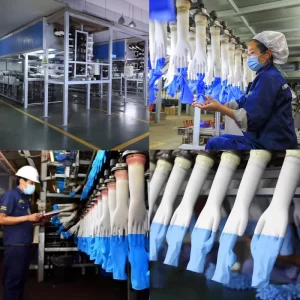The future of healthcare is increasingly intertwined with advancements in material science, and one area of significant innovation is in nitrile glove manufacturing. Nitrile gloves, known for their superior chemical resistance and durability, are becoming a critical component in the healthcare sector. Traditional manufacturing methods for these gloves have involved a combination of natural and synthetic latex, but recent developments are pushing the boundaries of these techniques to enhance glove performance and safety. One of the most promising advancements in nitrile glove production is the use of advanced polymerization techniques. These methods involve the synthesis of nitrile rubber with a greater degree of precision, resulting in gloves with improved elasticity and strength. By controlling the polymerization process more carefully, manufacturers can produce gloves that are not only more resistant to punctures and tears but also more comfortable to wear for extended periods. This is particularly important in healthcare settings where gloves are worn for long durations, and comfort can impact the quality of care and the health of the practitioner. Another innovative approach is the incorporation of nanotechnology into nitrile glove manufacturing.
 Nanoparticles can be embedded into the glove material to enhance its properties. For example, antimicrobial nanoparticles can be added to reduce the risk of cross-contamination and infection. This is crucial in preventing the spread of pathogens, especially in environments like hospitals where maintaining sterility is paramount. Additionally, nanotechnology can improve the glove’s barrier properties, making them more effective at protecting healthcare workers from harmful chemicals and infectious agents. Sustainability is also a significant focus in the future of nitrile glove production. Traditionally, the production of nitrile gloves has involved the use of non-renewable resources and generated considerable waste. However, new techniques are being developed to address these environmental concerns. One such technique is the use of bio-based nitrile materials derived from renewable sources. These materials not only reduce reliance on petrochemicals but also lower the overall carbon footprint of glove production. Moreover, advancements in recycling technologies are enabling the reuse of nitrile glove materials, further promoting sustainability in the industry.
Nanoparticles can be embedded into the glove material to enhance its properties. For example, antimicrobial nanoparticles can be added to reduce the risk of cross-contamination and infection. This is crucial in preventing the spread of pathogens, especially in environments like hospitals where maintaining sterility is paramount. Additionally, nanotechnology can improve the glove’s barrier properties, making them more effective at protecting healthcare workers from harmful chemicals and infectious agents. Sustainability is also a significant focus in the future of nitrile glove production. Traditionally, the production of nitrile gloves has involved the use of non-renewable resources and generated considerable waste. However, new techniques are being developed to address these environmental concerns. One such technique is the use of bio-based nitrile materials derived from renewable sources. These materials not only reduce reliance on petrochemicals but also lower the overall carbon footprint of glove production. Moreover, advancements in recycling technologies are enabling the reuse of nitrile glove materials, further promoting sustainability in the industry.
The automation of nitrile glove manufacturers processes is another key trend shaping the future of nitrile glove production. Advanced robotics and automated systems are being employed to streamline production lines, enhance precision, and reduce human error. These technologies not only increase the efficiency of glove manufacturing but also improve the consistency and quality of the final product. As a result, healthcare providers can rely on gloves that meet stringent safety standards and offer enhanced performance. Lastly, the integration of smart technology into nitrile gloves represents a groundbreaking development. Research is underway to incorporate sensors and electronic components into the gloves to monitor and provide real-time feedback on various parameters, such as exposure to hazardous substances or the integrity of the glove. This smart technology could revolutionize how gloves are used in healthcare settings, providing additional layers of safety and information for practitioners. In summary, the future of healthcare is set to benefit greatly from advancements in nitrile glove manufacturing. Through innovations in polymerization techniques, nanotechnology, sustainability practices, automation, and smart technology, nitrile gloves are becoming more effective, comfortable, and environmentally friendly.